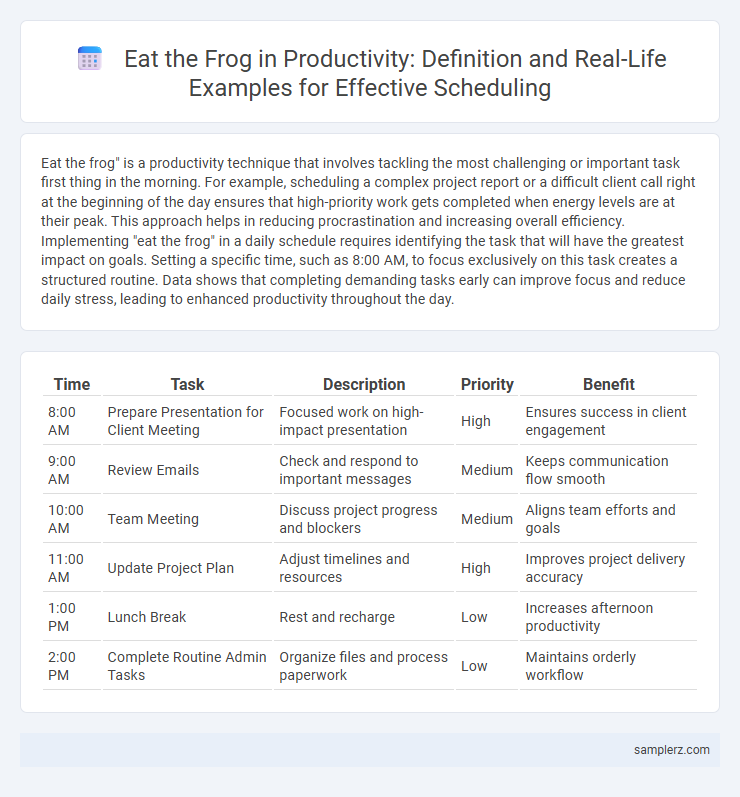Eat the frog" is a productivity technique that involves tackling the most challenging or important task first thing in the morning. For example, scheduling a complex project report or a difficult client call right at the beginning of the day ensures that high-priority work gets completed when energy levels are at their peak. This approach helps in reducing procrastination and increasing overall efficiency. Implementing "eat the frog" in a daily schedule requires identifying the task that will have the greatest impact on goals. Setting a specific time, such as 8:00 AM, to focus exclusively on this task creates a structured routine. Data shows that completing demanding tasks early can improve focus and reduce daily stress, leading to enhanced productivity throughout the day.
Table of Comparison
| Time | Task | Description | Priority | Benefit |
|---|---|---|---|---|
| 8:00 AM | Prepare Presentation for Client Meeting | Focused work on high-impact presentation | High | Ensures success in client engagement |
| 9:00 AM | Review Emails | Check and respond to important messages | Medium | Keeps communication flow smooth |
| 10:00 AM | Team Meeting | Discuss project progress and blockers | Medium | Aligns team efforts and goals |
| 11:00 AM | Update Project Plan | Adjust timelines and resources | High | Improves project delivery accuracy |
| 1:00 PM | Lunch Break | Rest and recharge | Low | Increases afternoon productivity |
| 2:00 PM | Complete Routine Admin Tasks | Organize files and process paperwork | Low | Maintains orderly workflow |
Understanding “Eat the Frog”: The Productivity Principle
Prioritize your most challenging task first thing in the morning to align with the "Eat the Frog" productivity principle, which emphasizes tackling high-impact activities that often cause procrastination. Scheduling this task at the start of your day leverages peak mental energy and reduces decision fatigue. This approach enhances focus by clearing major priorities early, setting a productive tone for the remainder of the schedule.
Why “Eat the Frog” Boosts Daily Efficiency
Prioritizing the most challenging task first, known as "Eat the Frog," significantly boosts daily efficiency by preventing procrastination on high-impact activities. Tackling the toughest task early maximizes focus and energy, reducing decision fatigue and increasing overall productivity. This method leverages cognitive momentum, ensuring subsequent tasks feel easier and more manageable throughout the day.
Identifying Your “Frog”: Prioritizing Difficult Tasks
Identifying your "frog" means pinpointing the most challenging and important task that can significantly impact your productivity and goals. Prioritizing this difficult task early in your schedule harnesses peak mental energy and reduces procrastination, ensuring critical work gets done first. This method aligns with time management principles by emphasizing task significance and enhancing focus on high-value activities.
Sample Morning Schedules Using “Eat the Frog”
Prioritize tackling the most challenging task first thing in the morning to maximize productivity, as demonstrated in sample morning schedules using the "Eat the Frog" technique. Block dedicated time slots between 7:00 AM and 9:00 AM for high-priority work, ensuring minimal distractions and enhanced focus. This method aligns with productivity principles by addressing critical tasks when mental energy peaks, leading to effective time management and task completion.
Integrating “Eat the Frog” Into a Weekly Planner
Integrating "Eat the Frog" into a weekly planner involves identifying the most challenging or important task each day and scheduling it during peak productivity hours. This method ensures high-priority tasks are addressed proactively, reducing procrastination and enhancing focus. By consistently tackling these critical tasks first, overall productivity increases and stress significantly decreases.
Real-Life Examples: Executives Who Eat the Frog
Top executives like Tim Ferriss and Elon Musk practice "eat the frog" by tackling their most challenging tasks early in the day, boosting productivity and decision-making efficiency. This technique aligns with studies showing morning focus peaks, enabling high-impact outcomes before distractions arise. Scheduling priority projects immediately after waking enhances goal completion rates and reduces procrastination for busy professionals.
Balancing Major and Minor Tasks in Your Schedule
Prioritize your most challenging or important task, often referred to as "eating the frog," at the start of your workday to maximize focus and energy. Balance this by scheduling smaller, less demanding tasks throughout the day to maintain productivity without burnout. Effective time-blocking techniques help ensure major tasks receive ample attention while minor tasks are efficiently managed.
Tracking Progress: The Impact of Early Task Completion
Completing the most challenging task first thing in the morning, known as "eating the frog," significantly boosts productivity by creating momentum for the day. Tracking progress through tools like digital planners or task management apps provides tangible evidence of early accomplishments, enhancing motivation. Research shows that early task completion reduces procrastination and improves overall time management efficiency.
Overcoming Procrastination with “Eat the Frog”
Prioritize your most challenging and important task at the start of your day by applying the "Eat the Frog" technique, which targets overcoming procrastination effectively. Scheduling this task first reduces decision fatigue and builds momentum, boosting overall productivity throughout the day. Research indicates this approach significantly enhances task completion rates and minimizes stress.
Adapting the “Eat the Frog” Method for Remote Work
Prioritizing the most challenging task first thing in a remote work schedule aligns with the "Eat the Frog" method to boost productivity. Allocating specific time blocks for high-priority projects helps maintain focus amid home distractions and enhances task completion rates. Integrating digital tools like task timers and virtual planners adapts this method effectively in a remote environment.

example of eat the frog in schedule Infographic
 samplerz.com
samplerz.com